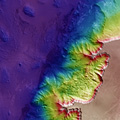E
EarthlingX
Guest
http://www.esa.int : Mars’s mysterious elongated crater
27 August 2010
Orcus Patera on Mars
Orcus Patera is an enigmatic elliptical depression near Mars’s equator, in the eastern hemisphere of the planet. Located between the volcanoes of Elysium Mons and Olympus Mons, its formation remains a mystery.
Often overlooked, this well-defined depression extends approximately 380 km by 140 km in a NNE–SSW direction. It has a rim that rises up to 1800 m above the surrounding plains, while the floor of the depression lies 400–600 m below the surroundings.















